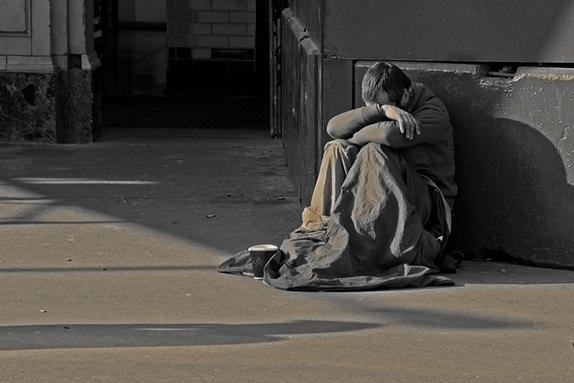
Two men who had been beaten to death with cinderblocks were found this weekend on Albuquerque’s Westside. These men were homeless, and police have only recently identified them because they were beaten beyond recognition. Three teenage boys--ages 18, 16, and 15--have been arrested and charged with two counts of murder. One of the boys, the 15-year-old, reportedly told police that the group had attacked at many as 50 homeless people in recent months. These acts are horrifying, disgusting, and stomach-turning. For me, these acts register on the extreme of my moral scale--even my imagination struggles to comprehend the realities of what occurred. At the same time, I wonder if I have anything in common with these boys. I think about the times I tried to discreetly roll up my windows or lock my car doors before arriving at an intersection with someone asking for money. I think about the times I tensed up and provided a wide berth as I walked by a person in ragged clothing. And, I think about all the times I lied when someone asked me for some change, a dollar, or anything to help. I like to think that I am not on the edge of committing a heinous act of violence as the boys have been charged with, but I am realizing that what I do ignores and dehumanizes people on the socioeconomic fringe. I wonder if I have these values in common with the boys who allegedly murdered the two homeless men. To better understand my acts of violence against people living in extreme poverty, I designed two hypothetical situations: one with a clear act of violence and another act that is common to my life. Throughout my evaluation, I define violence as an act that is intended to hurt, injure, or kill someone or something, and both physical and mental violence are considered. In short, many acts we consider crimes are violence by this criteria, but, while it is not a crime, our privilege to ignore someone in need, also, registers as violence.
Many instances of violence can be identified easily because we associate the act with state-placed label of crime. This label emphasizes what is right and wrong, whether it be theft, domestic violence, or murder. This state-influenced moral consciousness is re-enforced from a young age; we can hear “don’t take what’s not yours” and “don’t hit” from parents and early childhood teachers. And, we understand that these actions constitute violence because they use force with the intent to injure. Consider the following hypothetical situation in which you will be the perpetrator of violence. Walking home, you see a person sitting alone, not bothering anyone. You know, because this is a hypothetical situation, that this person is hungry. Not the kind of hunger a person feels when one decides to eat a meal or grab a snack, but the hunger that comes from not eating anything for days. It’s the type of hunger that keeps a person awake. You notice this person has a sandwich which he or she prepares to eat. You walk over and take the sandwich from the person without inflicting any physical harm. You are not hungry, and, when you get home, you will put the sandwich in the refrigerator. You may or may not eat the sandwich as the days pass. As observers, we know this act is violent. It is immoral, and, to my sensibility, it is appalling. We, also, know this act is a crime. It is theft; you have deprived someone of his or her property with the intent to keep it. Using the criteria for what constitutes a violent action, we see you in the hypothetical situation taking possession of the sandwich and, in turn, harming the person by leaving him or her hungry. The person has, also, been harmed emotionally. Defining emotional violence as an “any act including confinement, isolation, verbal assault, humiliation, intimidation, infantilization, or any other treatment which may diminish the sense of identity, dignity, and self-worth,” we understand that you have fulfilled this criteria too. You have isolated the person emotionally by making him or her feel loss, sadness, and even worthlessness. You have humiliated the person through embarrassment. You have intimidated the person, and the person feels fear, possibly paranoia, of this violation happening again because of your actions. This portion of the evaluation seems simple enough, but it is important to understand why this is an act of violence before moving on.
As we know, not all violence is labeled and punished by the state as a crime. I, also, believe it is more difficult to identify violence that we are culpable in. In the previous paragraph, even though you were implicated in the hypothetical violence, it was easy to identify because we know those actions are crimes and we know you have harmed a person in need through theft. Now, let’s consider a similar situation I, and probably you too, are more familiar with. Walking home, you see a person sitting alone, not bothering anyone. You know this person is hungry; the same kind of hunger the person is feeling in the first hypothetical. This time, you have a sandwich. After making eye contact with the person for a brief second, you turn your head away, and you walk by the hungry person. You are not hungry, and, just as before, you will put the sandwich in the refrigerator. You may or may not eat the sandwich as the days pass. As we know, your actions in this situation are not considered criminal by the state. You will not be punished by fine or jail time for walking by someone in need. But, using the definition of violence, the act of walking by someone in need, your act, is violence. You have harmed this person physically and emotionally. You walked by the person consciously knowing that it would injure him or her by prolonging the individual’s hunger. This assertion does not resonate with our moral consciousness as the first hypothetical did, but it fulfills the criteria for violence the same way. You knowingly harmed a person. You, also, injured the person through emotional violence. You did nothing to recognize the person’s hungry state. You denied the person’s humanity by looking the other way after seeing him or her; then, you walked by. You made the person feel isolated from the community where he or she lives; after all, you would feel similarly if you were in need, and no one stopped to help you. And, at the most basic level, you humiliated this person by simply not acknowledging his or her existence. This act is at its core dehumanizing violence.
Some will object to the application of the criteria in the second hypothetical situation. And, these people will not be alone in their initial reaction. Some will argue that walking by someone is different from taking something from someone. By law, it is. But, morally, it is not. In both situations, you have the power to help or hurt the person. Your choice of committing an act of violence or not exists in how you conduct yourself. People will, also, argue that walking by the person in need cannot be an act of violence because no physical force has been exerted on the person as it was in the first hypothetical when the sandwich was taken. The act of walking by someone in need is neglect, and, as our society understands neglect, it is a crime in certain circumstances. A person is charged with neglect if he or she leaves a child in a hot car during the summer. In this case, the person may simply walk away from the car not exerting a physical force on the child, but, legally, we know that person is responsible for the child’s welfare. Surely, neglect as violence towards a child, also, applies as violence towards an adult. In the case of the second hypothetical, you may not be legally responsible for the person in need, but you are morally responsible. And, whether you consider neglect action or inaction, it is violence.
Consider this evaluation in terms of professional responsibility. If a doctor did not help an injured person who would otherwise sustain greater injury or death without immediate care from the doctor, we would consider this doctor negligent. In this same way the doctor is obliged to act, we have a responsibility to the person in need. You may not have the medical knowledge to properly help an injured person. You may not have the proper training to help a person with counseling, or addiction, or mental illness, but you do have the ability to help someone who is hungry. And, that is why I think labeling walking by someone in need as a passive, nonviolent act is an excuse. It does not absolve me, you, or anyone else from your responsibility to another person--your humanity.
As I return to the three boys charged with the murders of the homeless men, I don’t think I am any closer to understanding what happened. Their acts and their thinking remain on the fringe of my understanding. But, I wonder if one of the boys ever saw me lock my doors as I pulled up to a stoplight with a person panhandling for change. I wonder if one of the boys saw me tell a person in need that I didn’t have any cash as I walked away quickly without making eye contact. I wonder if this tragedy could have been avoided if we asked people in need what their names are, how they are doing, and if we could do anything to help. I know, it sounds murky: we would get involved with our time and energy, our emotions, our resources. But, I wonder what it says about us when we neglect the people around us.



Responses to “Albuquerque’s Homeless Murders and Our Ordinary Passing Violence”